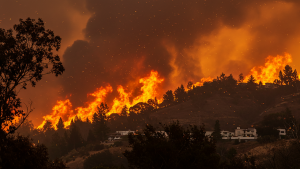HOW TO PROTECT YOUR HOME FROM WILDFIRES

Here in Los Angeles, we’ve gone through the worst wildfire season on record, with 16,000 homes and other structures destroyed in the Pacific Palisades and Alta Dena
fires. If we weren’t one of the unlucky ones to lose our home, we all know someone who did. It has been devastating and will take a long time to recover from and rebuild.
While nothing is a complete surety against disaster, there are many precautions you can take to protect your home from burning to the ground when threatened by wildfires.
Let’s talk about a few.
Protecting your home’s structure
Basically, you will need to harden your home’s structure, using non-combustible
materials for your roofing and siding. For the roof, using metal, asphalt, tile or clay will
prevent embers from igniting it, as they are all non-combustible.
For siding, your home should be built with stucco, brick or stone and NOT wood.
Inspect all of the foundation, attic and eaves vents to ensure they are properly installed
and have not been damaged. Repair any holes you find in their coverings. If you have an outside wooden deck, cover the underside with a fire resistant material.
Install spark arrestors over your chimney. These are screens or caps that fit over the top of your chimney and prevent embers from floating up and landing on your roof or piled up leaves that have accumulated there.
Dead dry leaves and vegetation are highly flammable, so clean out your gutters regularly.
Protect your home by creating a defensible space around it.
Walk all around your house and take note of any debris and dead leaves that have piled up in corners, on ledges, on the rooftop etc. Clear all dead and dry leaves and
vegetation from the immediate area. This includes combustible trash, pine needles, and dead vegetation that has accumulated under bushes.
Now, do the same procedure in a 30-foot perimeter around your home. Thin out any
dense tree canopies, and trim tree branches so that you have a clearance of 6-10 feet
off the ground.
When planning or installing any new landscaping, use non-combustible materials for the hardscape, like gravel or concrete, which will slow fire spread. Plant native and fire-resistant trees and shrubs. The California lilac is beautiful and will withstand a lot of
heat and flames. For trees, conifers, the oak tree and the sycamore are all surprisingly
fire resistant. Their wood is very dense and has a low ignition rate. Many oak trees,
though damaged, were not destroyed in the Eaton Fire in Alta Dena…a heartening
testament to surviving hardship.
Lastly, you will need to have a system in place that provides you with multiple water sources. Ensure your sprinkler system is working properly at all times. Use cisterns and rain barrels throughout the year to accumulate rain water, as meager as that can sometimes be here in SoCal. Have garden hoses around the house, ready to use. If you have a pool, consider getting a pump that you can use, turning your pool into a water source. One of the problems that can happen with the municipal water supply during a massive fire is that the water is being heavily tapped and so affects the water pressure for you. You might have just a trickle when turning on your hose.
While none of us can predict the future or control the sometimes-wild forces of nature,
following these very doable guidelines will give us some measure of security and a
fighting chance when the worst happens. Hopefully, you won’t need these measures,
but you will sleep more easily at night, knowing you took some common-sense steps to
keep you and your family safer!


No Comments